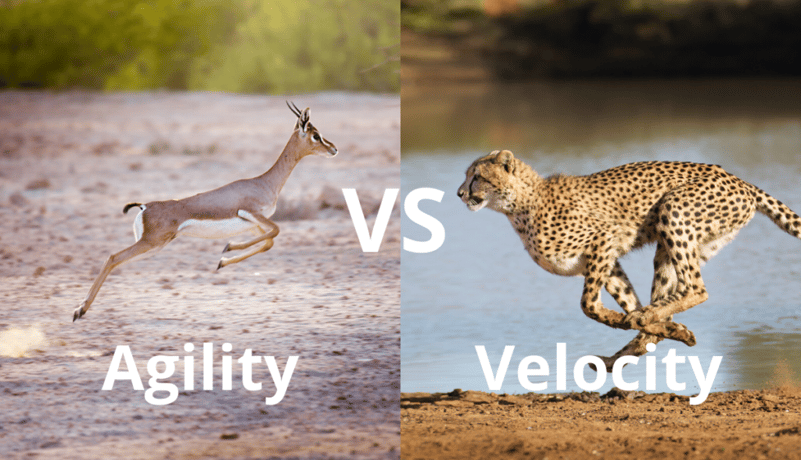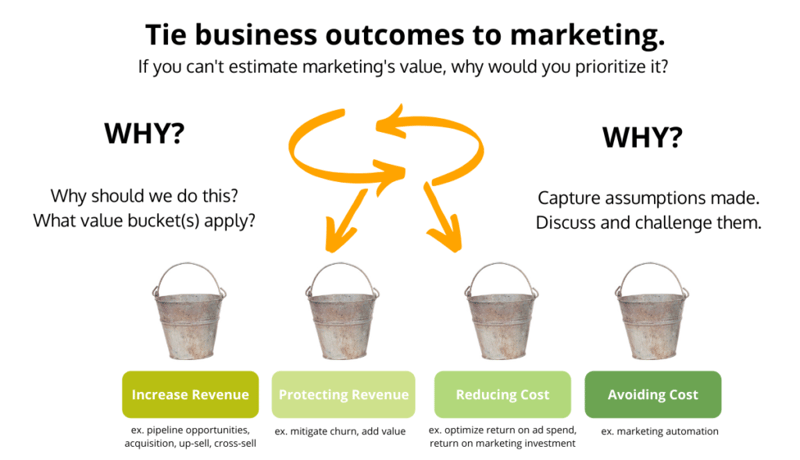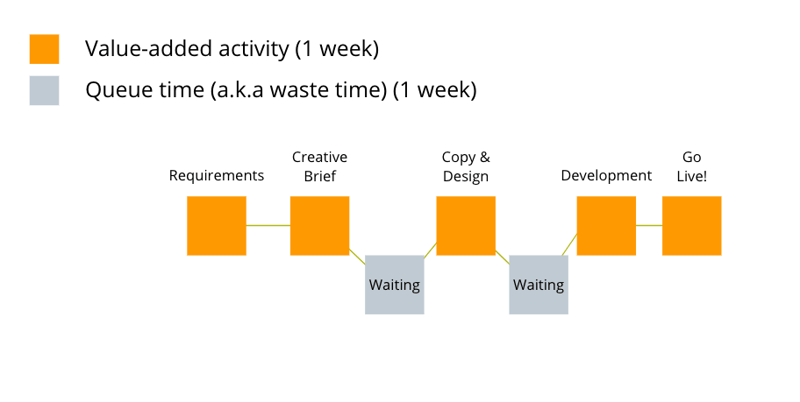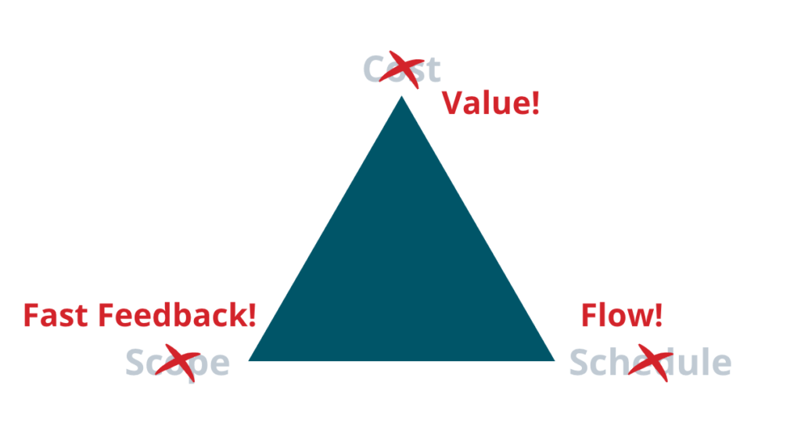Disclaimer: This post is part of a new AgileSherpas series on how to prove the value of Agile marketing with hard data. These articles assume that you already know why you should do Agile marketing, and even what you need to do, you just don’t know how to do it. If that’s not the case, this article is a great place to start.
Earlier in This Series on Process Metrics...
On the blog, we've already met an amazing trifecta of marketing metrics that help you measure your Agile marketing success, namely Efficiency, Cycle Time, and Throughput.
They’re all great starting points for marketers looking to improve their output, but Agile marketing pros know that output is only a small part of the Agile equation.
Business outcomes, not outputs, are what we’re really after.
The backlog is supposed to be the filter for making sure an Agile team’s work delivers solid outcomes, but you’d be shocked at how many times I hear marketers ask, “How do we prioritize our backlog for business outcomes?”
Ready to Add Another Metric to Your Arsenal?
In a world with limited marketing resources and conflicting priorities, where stakeholders want it all and want it yesterday, how can we do the right work at the right time? In this post, I’ll show you how to do just that using the powerful metric of Cost of Delay Divided by Duration (or CD3) to:
- Expose inefficiencies in your queue time (a.k.a. “wait waste”)
- Improve marketing prioritization: Replace prioritization by gut-feel, MoSCoW hell, or bowing to the HiPPO (Highest Paid Person’s Opinion) to outcome-driven prioritization .
- Change the focus of the conversation: Shift your conversations from cost to value, from schedule to speed, and from scope to feedback.
Why Use Cost of Delay?
As I explained in my last post, while Cycle Time is a useful metric, it’s a measure of speed, not agility. Speed refers to moving in a straight line, while agility is the ability to change direction quickly and effectively.
A good analogy is cheetahs and gazelles.

Cheetahs are far faster than gazelles, but rarely catch them, because gazelles can change direction more easily!
Let's use the example of going to Starbucks. What we want to know is how long the wait will be.
If we ask someone who just got her coffee how long it took, we’re asking about Cycle Time. The problem is the line (the queue) may have been totally different when she arrived, so what she says won’t be all that helpful.
In other words, Cycle Time is a lagging indicator.
If instead we knew the baristas’ average velocity, we could apply that to the size of the queue when we arrived in order to predict our Cycle Time.
Since queue size varies more than average velocity, it’s the best leading indicator of Cycle Time.

In order to predict the Cycle Time apply the barista’s avg. velocity to the size of the queue
How Cost of Delay is Related to Value
So what does this have to do with Cost of Delay? In his book “The Principles of Product Development Flow”, Don Reinertsen, an Agile thought leader, argues that:
“If you only quantify one thing, quantify the Cost of Delay” (Reinertsen, 2009)
Reinertsen shows that if you want to get the maximum business value from a given size marketing team, you should give them not the highest priority work, not the most valuable work, not the smallest work, not even the most urgent work.
The most value comes from having a marketing team focus on items with the highest value of urgency (or cost of delay (CoD)) divided by the time it takes to implement them.
Analyzing Cost of Delay (even if done qualitatively) is important because it focuses on the business value of marketing and how that value changes over time.
To put it bluntly, understanding the Cost of Delay is essential if you want to maximize the value of marketing to your customers.
What is Cost of Delay and How to Calculate It
A good way to understand Cost of Delay in marketing is to compare it to traditional cost.
“Cost” is how much money you pay to write, design, develop and advertise your marketing campaigns, for example.
“Cost of Delay” is how much money you lose (per unit of time) due to a delay in launching your marketing campaign.
Put another way, if your campaign will create business value in the form of leads, opportunities, pipeline, and eventually revenue, then a delay in launching it necessarily creates a cost.
Hence, Cost of Delay.
A simple way of thinking about Cost of Delay is:
CoD = The impact of time on business outcomes marketing is hoping to achieve
With CoD we’re putting a price tag on time.
We’re combining business value with a sense of urgency to arrive at the CoD.
The good news is that you don’t need to be able to precisely predict the cost of delay in order to make better tradeoff decisions by using it. The mere practice of estimating Cost of Delay is a catalyst for important conversations that wouldn’t otherwise happen.
These conversations help to surface marketers’ assumptions so that they can be challenged. It also shifts the conversation so the focus is less on marketing cost and deadlines and more on marketing value and speed.
Determining the Business Value of Marketing Work
In order to arrive at Cost of Delay for a marketing project, we need to first estimate what the business benefits would be if we delayed starting this project and instead started sooner.
What more could we get if launched in four weeks instead of eight?
Business value can typically be demonstrated by showing how marketing can:
- Increase revenue (pipeline, opportunities, acquisition, up-sell, cross-sell)
- Protect revenue (mitigate churn, add value)
- Reduce cost (optimize Return on Ad Spend, Return on Marketing Investment, etc.)
- Avoid cost (marketing automation)

To start, simply think about what would it be worth to the business if we had a particular marketing project right now. Just give a basic order of magnitude; it doesn’t have to be 100% accurate.
Take for example a (totally hypothetical) new demand generation campaign. It takes the marketing team eight weeks to gather requirements, put together a creative brief, write copy, design the landing page and content assets, get stakeholders’ feedback, develop the page, form and analytics, design the social ads and finally launch.
Based on past campaigns of the same type, we know that this campaign has the potential to generate another $600,000 in pipeline deals within one month. We also know that a third of that pipeline, or $200,000, typically converts to revenue.
In other words, every week we delay starting work on this campaign equals to $50,000 in Cost of Delay ($200,000/4)
Valuable ≠ Urgent: Looking at Project Duration
Remember that with Cost of Delay we’re looking for the impact of time on business outcomes that marketing is hoping to achieve, which means that business value alone is not enough. We also need to have some understanding of the urgency of the things we are working on.
For this we need to incorporate the marketing project duration.
Let's go back to the demand marketing campaign example. Between gathering requirements, putting together the creative brief, waiting for stakeholders feedback, writing copy, designing the landing page, developing the form, analytics etc. we estimate the duration of the project to be eight weeks.
Marketing Value-Add vs. Queue Time/ ‘Wait Waste’
Requirements (1 Week) - Creative Brief (1 Week) - Waiting (1 Week) - Copy & Design (1 Week) - Waiting (1 Week) - Development (2 Weeks) - Go Live (1 Week)

Estimating CoD allows us to expose the otherwise hidden cost of “queue time,” which is the time work spends sitting idle waiting for stakeholders’ feedback, waiting for legal approval, waiting for compliance review etc.
In the Agile world this is called queue time (like the line in Starbucks) or “wait waste.”
From Cost of Delay to CD3 (Cost of Delay Divided by Duration)
Now that we know the duration, we can arrive at the Cost of Delay Divided by Duration or CD3 (which also tells us how long the pipeline is blocked).
CD3 = (Cost of Delay/Duration)/1,000
| Marketing Project | Duration | CoD | CD3 |
| Demand Campaign | 8 weeks | $50,000 | 6.25 |
If you wonder why we divide by duration and not cost, the reason is that you can beg, borrow or “steal” money. You can also possibly throw in more resources and increase capacity, but you can never buy back time.
Working on other marketing priorities with lower CD3 is time lost, period!
How to Use CD3 for Backlog Prioritization
I’ve shown you how to arrive at CD3 for one project, now let’s use CD3 to prioritize your marketing backlog.
Document Your Marketing Projects
For the purposes of this example, let’s say you have three marketing projects awaiting attention. The first step to quantify Cost of Delay and determine the best order in which to tackle those projects is to mark them down side by side, including the expected duration of delivery and value.
| Marketing Project | Duration | Value |
| Demand Campaign | 8 Weeks | $50,000 |
| Blog Post | 1 Week | $750 |
| Event production | 9 Weeks | $20,000 |
| Landing Page | 2 week | $8,000 |
| TOTAL | 20 Weeks | $78,750 |
From there, you can calculate what’s known as the CD3, or the Cost of Delay Divided by Duration. To do so, simply divide the value by the duration and divide the answer by 1,000.
| Marketing Project | Duration | Value | CD3 |
| Demand Campaign | 8 Weeks | $50,000 | 6.25 |
| Blog Post | 1 Week | $750 | 0.75 |
| Event Production | 9 Weeks | $20,000 | 2.2 |
| Landing Page | 2 week | $8,000 | 4 |
| TOTAL | 20 Weeks | $78,750 | N/A |
When it comes to prioritization, you typically have the following options:
No Priority
If you work on all of the marketing projects at once, it will be 20 weeks until you see any value. Therefore, you eat the value of each project for the full 20 weeks. That means you lose the entire $78,750 each week for 20 weeks, for a total of $1,575,000 Cost of Delay.
Prioritize by Duration
You tackle your marketing backlog based on project duration, starting with the shortest duration first. If you prioritize based on duration, you would work as follows:
| Marketing Project | Duration | Value | Cost |
| Blog Post | 1 Week | $750 | 1x $750= $750 |
| Landing Page | 2 Weeks | $8,000 | (2+1) x$8,000= $24,000 |
| Demand Campaign | 8 Weeks | $50,000 | (8+3)x $50,000= $550,000 |
| Event Production | 9 Weeks | $20,000 | (9+11)x $20,500= $410,000 |
| TOTAL CoD: $984,750 |
You would eat the value of each marketing project until it and any project that comes before it are delivered. That works out to a total Cost of Delay of $984,750
Prioritize by Value
You tackle the backlog based on value, starting with the highest value project first. If you prioritize based on value, you would work as follows:
| Marketing Project | Duration | Value | Cost |
| Demand Campaign | 8 Weeks | $50,000 | 8 x$50,000= $400,000 |
| Event Production | 9 Weeks | $20,000 | (9+8) x$20,000= $340,000 |
| Landing Page | 2 Weeks | 8,000 | (2+17) x$8,000= $152,000 |
| Blog Post | 1 Week | $750 | (1+19) x750= $15,000 |
| TOTAL CoD: $907,000 |
You would eat the value of each project until it, and any features that come before it, are delivered. That works out to a total Cost of Delay of $907,000.
Prioritize by CD3
You tackle the backlog based on CD3, starting with the highest CD3 project first. If you prioritize based on CD3, you would work as follows:
| Marketing Project | Duration | Value | CD3 | Cost |
| Demand Campaign | 8 Weeks | $50,000 | 6.25 | 8 x$50,000= $400,000 |
| Landing Page | 2 week | $8,000 | 4 | (2+8) x$8,000= $80,000 |
| Event Production | 9 Weeks | $20,000 | 2.2 | (9+10) x$20,000= $380,000 |
| Blog Post | 1 Week | $750 | 0.75 | (1+19) x$750= $15,000 |
| TOTAL CoD: $875,000 |
You would eat the value of each feature until it and any features that come before it are delivered. That works out to a total Cost of Delay of $875,000.
Compare Your OptionsComparing your options side by side, you have an easy choice when it comes to Cost of Delay, with the CD3 prioritization option costing the least amount of money.
| Prioritization Option | Cost of Delay |
| No priority | $1,575,000 |
| Prioritise by Duration | $984,750 |
| Prioritise by Value | $907,000 |
| Prioritise by CD3 | $875,000 |
Change The Focus of the Conversation with CD3
CD3 not only helps you prioritise your marketing backlog; it can also help you change the focus of the conversation inside the marketing team, with senior management, and between marketing and the business.
With CD3:
-> Rather than obsessing about how much the project cost, we are much more interested in what the value of the project is.
-> Instead of worrying about when the project is going to be delivered, we care more about what’s the end to end cycle time and how we shorten it.
-> Rather than worrying about scope, we’re more interested in faster feedback.

Change The Focus of the Conversation with CD3
| Prioritize by Cost | Prioritize by CD3 |
| How much does it cost? | What’s the business value? |
| When can you deliver? | How can we shorten the cycle time? |
| What’s the scope? | How can we iterate based on feedback? |
To recap, If you want to take your Agile marketing game to the next level, Cost of Delay (CoD) is a vital metric to understand and measure. It should be your guide to prioritizing marketing work, even if -- as is often the case -- estimating it quantitatively may be difficult.



